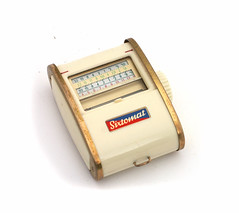Difference between revisions of "Exposure meter"
m (→light meters in cameras) |
Rebollo fr (talk | contribs) m (removed a duplicate header above the page, and small markup change) |
||
| Line 1: | Line 1: | ||
| − | |||
A '''light meter''' (short form ''meter'') is a device that measures light to determine the proper exposure settings for a scene. Analog measuring instruments with photoelectric selenium photo cell as voltage source were the most common models of light meters for the average photographer. Nowadays digital instruments with other types of light sensors dominate the market, but selenium meters are still popular since they need no battery. | A '''light meter''' (short form ''meter'') is a device that measures light to determine the proper exposure settings for a scene. Analog measuring instruments with photoelectric selenium photo cell as voltage source were the most common models of light meters for the average photographer. Nowadays digital instruments with other types of light sensors dominate the market, but selenium meters are still popular since they need no battery. | ||
{{Flickr_image | {{Flickr_image | ||
| Line 8: | Line 7: | ||
}} | }} | ||
| − | == | + | == Light meter makers == |
| − | *[[Gossen]] | + | * [[Gossen]] |
| − | *[[Minolta]] | + | * [[Minolta]] |
| − | *General Electric | + | * General Electric |
| − | *Lux | + | * Lux |
| − | *Ernst&Wilhelm Bertram | + | * Ernst&Wilhelm Bertram |
| − | *Soligor | + | * Soligor |
| − | *[[Zeiss Ikon]] | + | * [[Zeiss Ikon]] |
and many others | and many others | ||
| − | == | + | == Light meters in cameras == |
Automation of exposure control in cameras began with built-in selenium meters. Shutter speed and aperture had to be selected manually according to the meter's absolute or relative measured values. With the advent of electrically controlled diaphragms and shutters other light sensors like photo resistors, photo diodes etc. became common parts in cameras. Both sorts of devices needed batteries for operation. Some additional electronic circuits combining meter with shutter and diaphragm units were just needed to get exposure control automated. This sort of camera emerged in the 1960ies. | Automation of exposure control in cameras began with built-in selenium meters. Shutter speed and aperture had to be selected manually according to the meter's absolute or relative measured values. With the advent of electrically controlled diaphragms and shutters other light sensors like photo resistors, photo diodes etc. became common parts in cameras. Both sorts of devices needed batteries for operation. Some additional electronic circuits combining meter with shutter and diaphragm units were just needed to get exposure control automated. This sort of camera emerged in the 1960ies. | ||
| − | |||
| − | |||
{{glossary}} | {{glossary}} | ||
Revision as of 09:54, 21 October 2006
A light meter (short form meter) is a device that measures light to determine the proper exposure settings for a scene. Analog measuring instruments with photoelectric selenium photo cell as voltage source were the most common models of light meters for the average photographer. Nowadays digital instruments with other types of light sensors dominate the market, but selenium meters are still popular since they need no battery.

|
| Gossen Sixtomat, a popular selenium meter |
Light meter makers
- Gossen
- Minolta
- General Electric
- Lux
- Ernst&Wilhelm Bertram
- Soligor
- Zeiss Ikon
and many others
Light meters in cameras
Automation of exposure control in cameras began with built-in selenium meters. Shutter speed and aperture had to be selected manually according to the meter's absolute or relative measured values. With the advent of electrically controlled diaphragms and shutters other light sensors like photo resistors, photo diodes etc. became common parts in cameras. Both sorts of devices needed batteries for operation. Some additional electronic circuits combining meter with shutter and diaphragm units were just needed to get exposure control automated. This sort of camera emerged in the 1960ies.